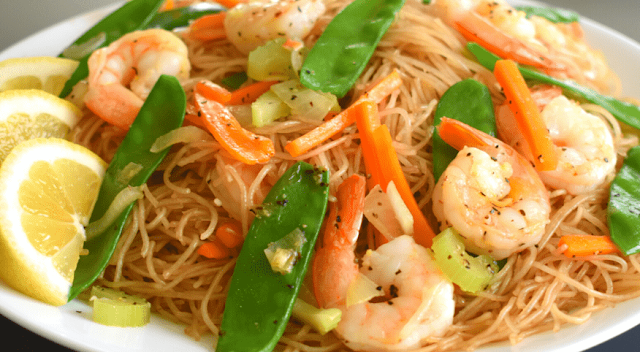Pancit Bihon Guisado, a cherished Filipino dish, beckons with the tantalizing aroma of stir-fried rice noodles and the vibrant medley of colorful ingredients. This classic dish is a harmonious marriage of thin rice noodles, tender meats, and an array of vegetables, all wok-tossed to perfection.
To prepare this gastronomic delight, thin rice noodles are soaked and softened before being stir-fried with a savory blend of soy sauce, fish sauce, and oyster sauce. The foundation of the dish often involves sautéing garlic, onions, and sometimes, diced pork or chicken until they release their aromatic essence.
The ensemble of colorful vegetables, such as carrots, snow peas, and cabbage, adds both texture and visual appeal to the dish. Some variations may include shrimps or sliced Chinese sausages for an extra burst of flavor.
Pancit Bihon Guisado is not just a culinary masterpiece; it is a symbol of longevity and celebration in Filipino culture. Often present at festive occasions and family gatherings, this dish embodies the Filipino spirit of generosity and togetherness. Served with a wedge of calamansi and sometimes sprinkled with chopped green onions and crispy fried garlic, Pancit Bihon Guisado is a delightful representation of Filipino culinary artistry and conviviality.
Pancit Bihon Guisado or Rice Noodle Saute
Recipe by KulinaryaIngredients: Serve 6
- 4 cups cold water
- ½ tsp salt
- ¼ tsp whole black peppercorns
- 250g pork belly (liempo)
- 200g shrimps(50pcs to a kilo)
- 30g dried shitake mushrooms
- Water for soaking mushrooms
- 2 cloves garlic
- 1 onion
- ¼ tsp salt
- ½ tsp ground black pepper
- 4 tbsp soy sauce
- 2 tbsp fish souce
- 100g cabbage
- 1 small carrot
- 60g small carrot
- 60g cabbage
- 1 small carrot
- 60g green beans (habichuelas
- 12 bilimbi(kamias)
- 6 calamansi
- 500g thin rice noodles (bihon)
- 2 tbsp oil
Preparation:
- In a small pot, boil the water, salt, whole black pepper and pork belly. Simmer 82C or 180F until the pork is fork tender. Remove the cooked pork from the broth. Cut out the fat portion from the top of the belly. Set aside. Slice the fat and meat into strips separately. Set the pork broth aside.
- Peel and devein the shrimps. Reserve the heads and shell trimmings to make the shrimp stock.
- Soak the dried shiitake mushrooms until soft. Drain and discard the hard stems. Cut the caps into ½ cm strips.
- Crush, peel, and mince the garlic.
- Peel and chop the onion.
- Cut the cabbage in julienne strips of ½ cm or ¼ in.
- Peel and cut carrot into julienne strips.
- Remove both ends and string of the beans. Cut diagonally into ¼ in long strips.
- Slice the kamias crosswise thinly.
- Halve the calamansi.
Cooking:
- In a wok, add the pork fat portion that was set aside and render oil until crispy. Set aside the crispy fat. Using the same oil, saute the garlic, onion, shrimps, and sliced pork. Add the shrimp stock.
- Season with salt, pepper, soy and fish sauces.
- Add the carrots and green beans. Stir fry for 1 minutes.
- Add the pork broth and let boil.
When ready to serve:
Add the dry rice noodles and toss with the rest of the cooked ingredients.
Cook until all the liquid and the cooked ingredients have been absorbed and incorporated into the noodles. Serve hot immediately. End.










0 Comments